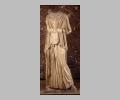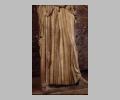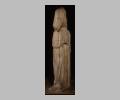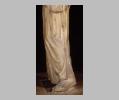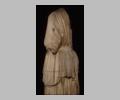| Collection: | Paris, Musée du Louvre |
| Title: | Copy of Athena of the |
| Summary: | Young Athena from the two-figure group with the silen Marsyas |
| Object Function: | Victory? |
| Material: | Marble |
| Sculpture Type: | Free-standing statue |
| Category: | Original/copies |
| Style: | Early Classical |
| Technique: | In-the-round |
| Original or Copy: | Copy |
| Original: | Athena and Marsyas Group |
| Dimensions: | H 1.46 m, (compare to H of Frankfurt Athena, including head 1.73 m) |
| Scale: | Under life-size |
| Period: | Roman |
Subject Description:
Statue of a young Athena in peplos, usually accepted as the Athena which together with a statue of Marsyas comprised a two-figure group by the sculptor Myron. The identification of the group is based on several kinds of evidence: literary references, images of the group on coins and vases, and a number of copies which clearly derive from a single archetype, probably in bronze.
The most complete copy and the only one which preserves the head is in Frankfurt. The copy in the Louvre exhibits slight differences but is clearly based on the same original. Athena steps to the left, placing her weight on her right leg and trailing her left leg behind. She looks back over her left shoulder — at Marsyas, from whom she is stepping away. She wears a belted Doric peplos with an overfold which reaches to her hips. The portion of the drapery over the upper torso forms a large "V" in front which descends to the waist, with a mass of narrow folds to the side of each breast. In the center below the waist is a single, very wide fold, again emphasized by the numerous smaller folds to either side. The skirt of the peplos descends in unbroken vertical folds over the weight leg and between the legs, while the fabric is caught over the knee and calf of the free leg.
Our knowledge of the sculpture stems from Pausanias's statement (
The subject stems from the story of Athena's invention of the double flutes. She saw a reflection of herself while playing them one day and, disliking the image of her puffy cheeks, threw them on the ground. Marsyas saw them and moved to pick them up. Apparently Athena did not strike him literally, but with her eyes, as a warning that he was not to touch the things of the gods. This is the moment represented. He could not resist the temptation and later lost his skin for daring to challenge Apollo's musical preeminence. That image of Marsyas was also immortalized in sculpture, but at another time.
The combining of the Frankfurt Athena and Lateran Marsyas has occasionally been questioned. The fact that he, a mortal, should be as tall as the goddess has been bothersome, but in fact his head does not rise above hers. Her small scale and slight body frame are explained by her young age, appropriate in the case of such youthful vanity. A young Athena was also represented on the Olympia metopes, though perhaps not as young as she is here. A second problem according to some scholars concerns the date of the Lateran Marsyas type, i.e. whether he is not an invention of the later 5th century. However, comparison with the Parthenon sculptures suggests that he could be contemporary. The subject of Marsyas begins to appear on Athenian vases at about the same time. Melanippides also wrote a play about him. Although its date is not known, it is possible that the play provided the inspiration for the outpouring of visual images. It has also been suggested Myron's group may have been designed in honor of a victory by that play in a dramatic contest (
Condition: Intact
Condition Description:
Statue of torso in one piece with plinth. Broken at neck, right shoulder and left elbow. Fragments of drapery also missing, especially lower edge of overfold, along the vertical folds and in the back where the peplos closely follows the arms.
Sources Used:
Other Bibliography:
